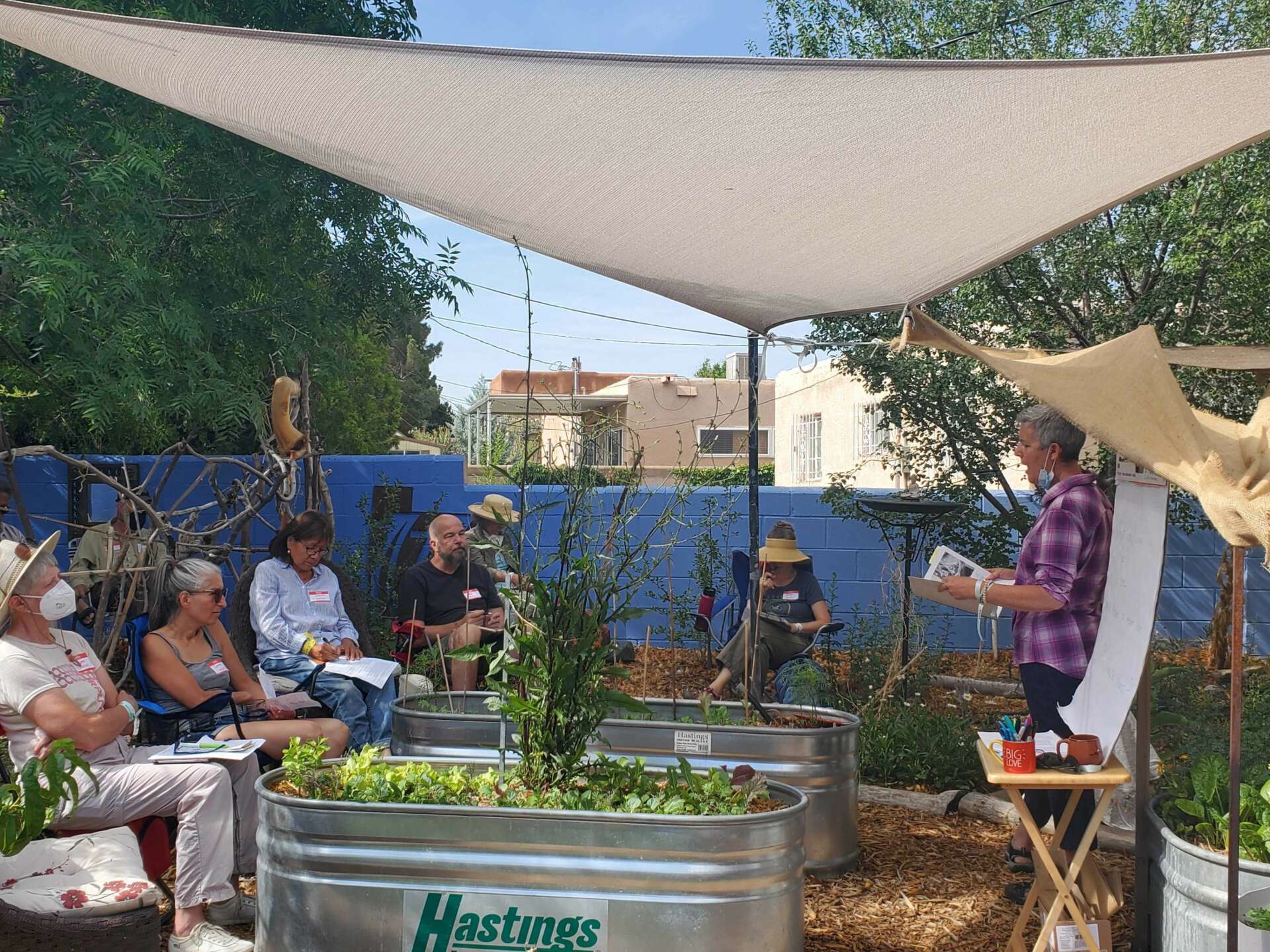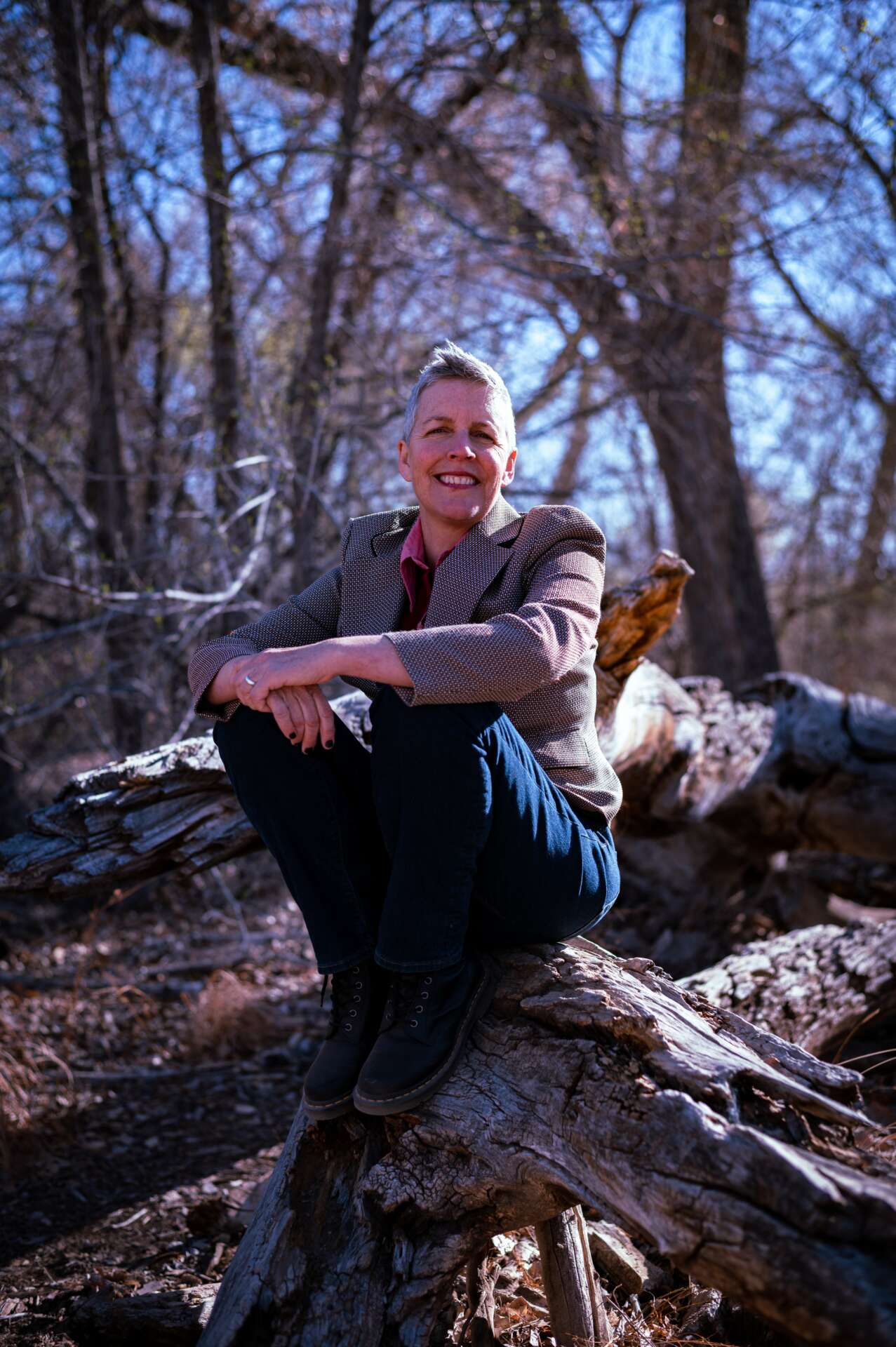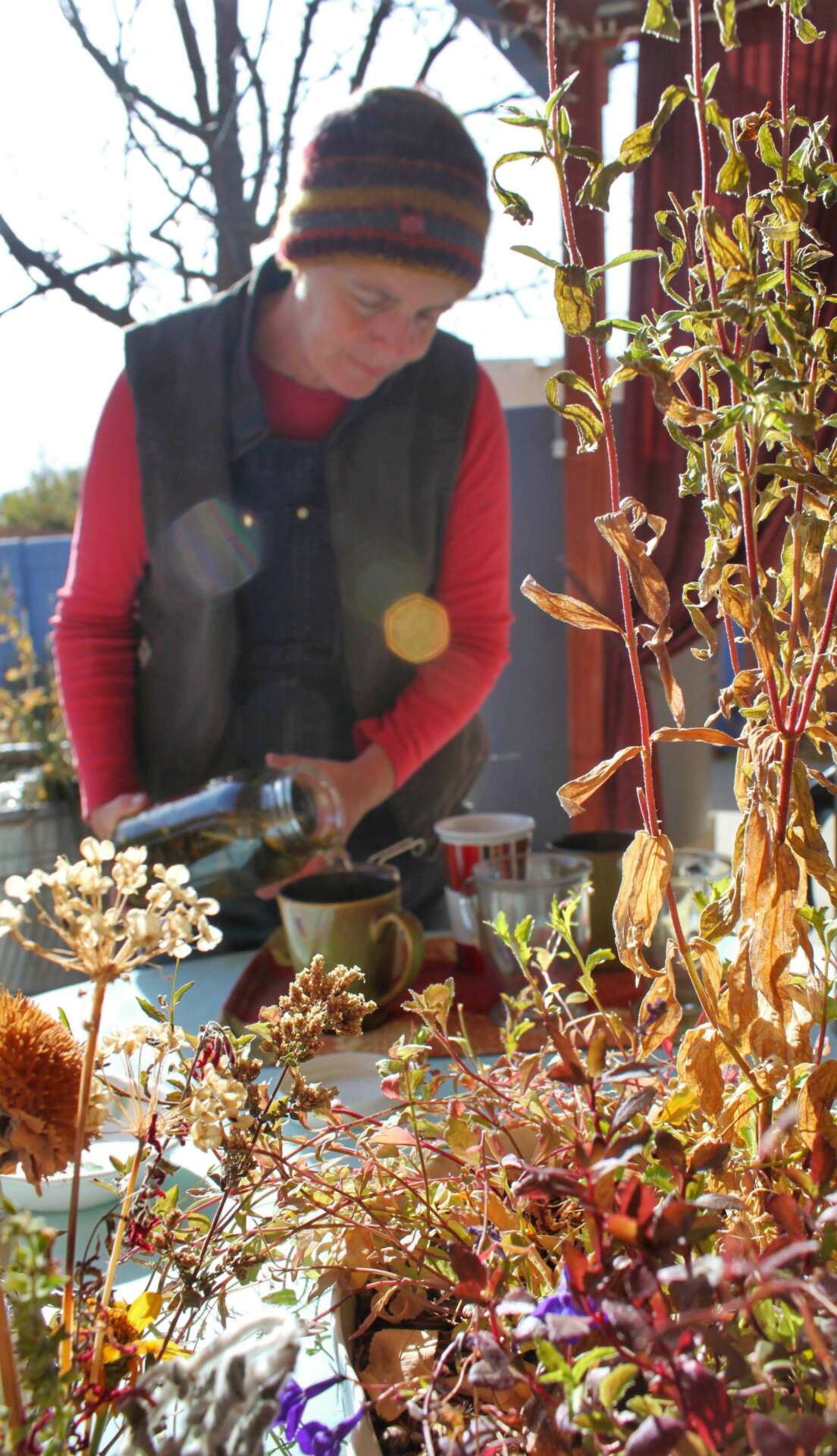We were lucky to catch up with Corva Rose recently and have shared our conversation below.
Corva , thanks for taking the time to share your stories with us today Can you tell us the backstory behind how you came up with the idea?
For about 25 years, I ran a service business in the trades – doing aesthetic pruning and restoration of shrubs, trees, and vines for homeowners here in Albuquerque, NM. I had a great crew of folks working for/with me, and we were successful and having a good time. But over those 25 years I was also watching the climate crisis deepen, and witnessing how the plants and landscapes I was working with were being affected by the increased heat, erratic freezes, and worsening drought. I could also see that the people I was working with, including myself, were becoming increasingly anxious and scared about the future.
In 2018-19 I began some active soul-searching – trying to figure out how I could pivot what I was currently doing into something more climate-related. Even though not much changed ‘above ground’ there were a lot of ideas (seeds!) planted during this time. One of those seeds was the name Tree School, which my stellar office manager at the time came up with. I also wrote the work ‘Sabbatical’ on a piece of paper and taped it to the wall of my home office. And I started really asking myself what I really wanted.
And then the Pandemonium happened. I put my business into dormancy for a while and began to work and play in my own home garden, something I had been too busy to do in the past. Eventually, I took the plunge to really let go of not just the old business, but who I was in relation to it. As the world unraveled, I unraveled. This Letting Go phase was crucial. I let go of old patterns (such as over-working and endless running on the hamster wheel of productivity); I let go of the old business model (getting bids, scheduling jobs, doing the actual pruning work, invoicing); and I let go of who I was in the world (a woman in the trades, with a crew, customers, and a business). Stepping over these thresholds again and again was key to creating space for the new model to arise.
As I continued to compost, so to speak, the old model and way of being, the soil in my mind became more and more fertile and something new began to coalesce. I remember the day that the words started to appear for something that had previously just been a feeling, an experience. I had been trying to explain to a few colleagues this sense I was getting – that when we focus just on the gardens themselves, we miss something very important. We miss what’s going on inside, in the vast, spacious garden in our own heart – our wishes, hopes, fears, dislikes, biases…and strongest of all, our deep love and compassion for others, which often gets clouded and covered.
I was also trying to explain to the same colleagues this other sense I was getting — that modern, western gardening was inseparable from colonialism, capitalism, and white supremacy. Historically, modern gardening is about getting other people (usually People of Color) to do the actual work, so you can have your own stellar garden, separate from other people, and hidden away from the world. I’m not saying this in judgement, but to expose what might be our biases about gardening, what we can unconsciously tend to want in a garden.
I was in this conversation with these (very patient and creatively engaged) colleagues, and it started to all coalesce! They drew it out of me — The Interconnection of the Three Gardens – The Home Garden, the Inner Garden at the Heart, and the World Garden.
As we tend the garden at home – learning climate-adaptive strategies for example – we also must tend the garden inside, the garden in our heart. The work we do outside is interconnected with the work we do inside – healing the fear and worry we have about the climate crisis for example, and learning to cultivate joy. Otherwise, we are just planting trees with more anxiety and guilt. And as we do this, we can consciously connect with the world and let this joy ripple out to create the world we want.
I created a Venn diagram of the Three Gardens, and started to share this with people, and I noticed that many people immediately resonated with it. I created a Mentorship program and beta tested it, and people joined, and we had a great time! I began to really see that when people worked at tending all three gardens, especially together as a group, an experience of inner climate resilience began to grow and ripple out, and their Home Gardens thrived.


Awesome – so before we get into the rest of our questions, can you briefly introduce yourself to our readers.
I have over 30 years of experience in the field of landscaping, gardening, farming, and arboriculture. I feel most at home in the dirt, inside a bush, or up in a tree. But I never thought I’d end up in this field. It was kind of an accident, a desperation. I’d studied English Lit and Women Studies in college, and spent my early 20’s living on a farm in rural Oregon. When I left the farm and made my way back down to the Bay Area in Cali I just couldn’t see myself working inside. Something had changed in me — I’d been introduced to the healing power of dirt, leaves, and roots. And now here I was looking for work, and starting to make the conscious decision to look for work in an area that felt good to me, that resonated. Landscaping became my way to be outside, work, and help people all at the same time.
I eventually gathered certifications in related fields – pruning, geomancy, permaculture, dowsing, arboriculture – and spent over two decades running a pruning business.
Then in 2021 I started Tree School, which is the next evolution of my work. I now help people to create climate resilient gardens to feed themselves and the wildlife who live with them. Together, we learn to tend our Home Gardens, the Inner Gardens in our Heart, and ripple it out to the World Garden.
I work 1:1 with people in Private Sessions; I teach quarterly Playshops in the community; and I run an 8-month Mentorship for a small cohort.
I help people who are gardeners, want-to-become-gardeners, and everything in between, who feel deeply about the climate crisis and the suffering in the world, and want to be a positive force for healing and change, but find themselves getting overwhelmed and frozen about how best to use their energy in service.
They’re ready to use their garden space to be part of the solution, but they wonder where to start and what to do.
They often feel fearful and anxious about the unraveling of climate, both locally and globally. They want to know how to effectively prepare for what’s coming, and how to pivot and respond as things change. They want to make the most of the time they have, but they know that a light touch and a loving heart will be more fruitful than pushing for results with a worried state of mind.
They might feel intimidated or unsatisfied by mainstream gardening classes or instructional videos that don’t feel like they speak to their sensitive heart, their worldview that includes equity and justice, or the sovereignty of the Indigenous peoples who are the original stewards of this bioregion.
They long for instruction that speaks to their specific garden and helps them develop the skills they need.
They’re ready to be part of a like- minded community of supportive gardeners who are digging deep together, creating a world where we all feel we belong.
They’re very clear about not spraying harmful chemicals in their yard but now want to learn more about how to actually cultivate a healthy garden ecosystem.
They’re concerned that wildlife are losing habitat at an alarming rate, and their heart hurts thinking about how the climate crisis is affecting them.
They’d like to learn how to make their space both wildlife friendly and a thriving garden that humans can eat from as well.
Over the past two years I’ve seen people achieve some amazing results. My students have been able to:
• Use depth of feeling to become a more effective, loving presence in their spheres of influence (family, neighborhood, circle of friends, city, or workplace).
• Feel clear, on-purpose, and good about their role and engagement in the world.
• Receive help with a plan/design, and also with making solid, important decisions – thus saving time/money.
• Learn the gardening skills they need, and experience cohesive, steady, holistic progress that continues and develops into the future.
• Feel joyful, confident and clear about how to foster more adaptability, and what actual steps to take.
• Learn the skills needed to transform their yard into the climate resilient garden they want.
• Feel confident in their good-hearted gardening practices.
• Certify their space as Wildlife Habitat.
• Become an informed and knowledgeable habitat advocate.
• Get to see more wildlife using the space and receiving benefit, which feels so good!


Let’s talk about resilience next – do you have a story you can share with us?
About ten years ago, my spiritual community went through a shocking collective experience that ended up creating a schism, a division in the community. If you’ve ever been through this, you know how stressful and hopeless it can feel. Everyone was affected. We all tried many ways to heal the split. It was good, of course, that we tried different methods, because we planted good seeds in the process, but the division still hung in the air for ten long years. I worked so hard during this time to not lose my faith, and I came very close to walking away during a few really challenging times. But I reached out to my spiritual teachers and close spiritual friends for help, and I laid down my pride on many levels. I learned to be easier on myself, and to nurture my steadfastness and ability to rest, both. And I learned to have respect, and eventually love, for people who had very different views than me.

What do you think is the goal or mission that drives your creative journey?
My mission is to spread the understanding and experience that climate resilience and adaptation come from nurturing the growth in three gardens simultaneously – the Home Garden (whatever land you are stewarding), the Inner Garden in the Heart, and your relationship with the World Garden.
This view and mission permeate everything I create, and everything I teach in Tree School.
For example, today I was creating some swales and berms around a jujube tree in my Home Garden. Swales and berms are types of earthworks that help water to slow, spread, and sink into the soil, thereby increasing the water storage capacity in the soil, and helping the tree to be more resilient. As I was doing this, I became aware of the insects living in this area. I took a few moments to tune into my Inner Garden, and to cultivate respect and compassion – wishing to not cause harm or destroy any homes/habitat. As I made the swales and berms, I carefully arranged the rocks to that I didn’t hurt the spiders, etc, and I made more hiding places for them. Every habitat we cultivate, no matter how small, is part of the patchwork quilt of habitat that extends over our entire bioregion, our continent, our world.

Contact Info:
- Website: https://treeschoolnm.com/
- Instagram: @tree_school_nm
- Youtube: @corvarose6269
Image Credits
Photos: Keith Coughenour + Katrina Giunta


